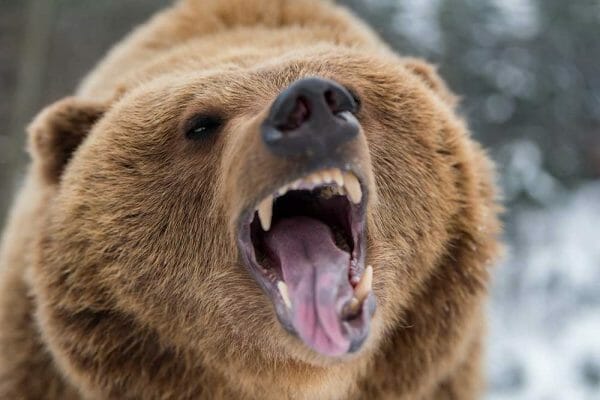
U.S.A. –-(AmmoLand.com)-– This is another in a series of self-defense against bear events uncovered in a Freedom of Information Act request done by AmmoLand. It seems they have not been published before.
At about 10 a.m. on the morning of May 28, 2016, a father-son pair of shed antler collectors were searching for antlers in the Bear Creek drainage of the Shoshone National Forest, about 16 miles northeast of Dubois, Wyoming.
The father and son had separated. The father went up a draw, and the son went up a side hill to a flat bench. The son had reached the top of the bench when he saw a “brown flash” in the tree line above him. He thought his father had probably flushed an animal out of the draw. As he looked at it again, he realized it was a grizzly bear, and it was running toward him.
The son yelled at the bear and drew his Springfield sub-compact. He did not have a round in the chamber. The Springfield comes with a 9 round and a 10 round magazine. He chambered a round and checked to be sure the safety was off. The pistol was new. He had never fired it before. His father had owned the same model for some time.
The son noticed, as the bear continued to run at him, that it appeared to be in full charge mode, with its ears laid back. He noticed a cub was with the sow. As the sow came within 30 yards of him, he started firing at the bear and moving to put a small tree between him and the charging grizzly.
The son fired his final rounds as the charging bear approached within feet. The bear went down and slid downslope about five yards where it died. In the investigation which followed. Ten .40 caliber brass were found at the scene. The brass was within 2-3 yards of the bear, putting the location of the defender within 5-6 yards of where the bear expired.
After the last shot, the son yelled “Get some!” and, perhaps, he admitted, “b****!” He then said a little prayer.
The ammunition used was PPU .40 caliber Smith & Wesson Total Metal Jacket 180 grain bullets. The Springfield sub-compact has a 3-inch barrel. It is a small pistol.
After the bear was down, the defender realized the cub had also been shot. It appeared to be a mortal wound, from below the right eye to the left ear.
The sow had four bullet holes on the right side of the chest cavity and one bullet hole from under the right eye to behind the right ear. One of the chest cavity bullets had penetrated the bear’s spine. Another bullet had perforated the right bicep of the bear. It may have continued into the chest cavity.
The head wound on the bear indicates the bear’s head was pointed directly at the defender. If the bullet had been two inches to the defender’s right, it would likely have been an immediately fatal wound.
Neither the father or the son was carrying bear spray. The son described an incident where he had been charged by a bear, and the bear spray did not work. He believed the only reason the bear stopped in that incident, was because other people nearby were yelling at it.
During the investigation, the cub was found to be still breathing. It was euthanized.
On April 7, 2017, the US Fish & Wildlife Service Special Agent received a letter of Declination for Prosecution from the Assistant United States Attorney for the District of Wyoming.
Opinion:
The son does not seem to be a highly trained pistol shooter. Highly trained pistol shooters do not take their new pistol out in the woods without ever firing it. However, the son performed well. He hit the attacking bear with at least five of ten shots. One of the other shots hit the cub.
Pistols are made to be highly ergonomic. It appears most people shoot reasonably well when confronted with an attacking animal at close range. Training and practice help. This correspondent has been surprised at how well people with little training or practice do during conflicts with bears. However, all three recorded cases of failures when using pistols to defend against bears appear to involve people with little training or practice.
About Dean Weingarten:
Dean Weingarten has been a peace officer, a military officer, was on the University of Wisconsin Pistol Team for four years, and was first certified to teach firearms safety in 1973. He taught the Arizona concealed carry course for fifteen years until the goal of Constitutional Carry was attained. He has degrees in meteorology and mining engineering, and retired from the Department of Defense after a 30 year career in Army Research, Development, Testing, and Evaluation.

